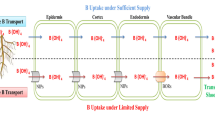Abstract
As chromium is widely used in many industries of which leather industries are the biggest consumers, wastes from tanneries pose a serious threat to the environment. Present research conducted greenhouse pot experiments on several plants using different solutions to find out their phytoextraction potential. Among the plants, Urtica dioica found to be very effective due to its higher uptake capacity for chromium. The analyses showed that with 500 mg/l solutions Cr concentration in roots was 38.9% higher (average 20 mg/kg) than plants fed with 200 mg/l solutions (phytostabilisation), while with 200 mg/l solutions more Cr was transported to leaves (phytoextraction), 10.52% higher (average 9.5 mg/kg) concentration than plants fed with 500 mg/l solutions, but also means that plants were less affected by toxicity. Zea mays showed high tolerance towards Cr with negligible concentration in leaves. Although average Cr concentration in Brassica napus is lower (25% and 21% for 200 mg/l and 500 mg/l solutions respectively) than Urtica dioica which still could account for phytoextraction, but due to its high vulnerability to insects its potentiality has downgraded. Among other elements, K being a component of the salt, played significant role for plants growth and survival—opening new avenue for phytoremediation of contaminated sites.





















Similar content being viewed by others
References
Barcelo J, Poschenrieder C, Gunse B (1986) Water Relations of Chromium VI Treated Bush Bean Plants (Phaseolus vulgaris L cv Contender) Under Both Normal and Water Stress Conditions. J Exp Bot 37:178–87
Chaney RL, Malik M, Li YM, Brown SL, Angle JS, Baker AJM (1997) Phytoremediation of soil metals. Curr Opin Biotechnol 8:279–284
Dietz AC, Schnoor JL (2001) Advances in Phytoremediation. Environ Health Perspect 109(suppl 1):163–168
Dzantor EK (2000) Phytoremediation—plant-based strategies for cleaning up contaminated soils: metal contaminants. Fact sheet 768. Maryland Cooperative Extension, University of Maryland.
Edwards SC, MacLeod CL, Lester JN (2004) The bioavailability of copper and mercury to the common nettle (Urtica dioica) and the earthworm eisenia fetida from contaminated dredge spoil. Water Air Soil Pollut 102:75–90
Fern K (1997) Plants for a future—edible & useful plants for a healthier world. Permanent Publications, Hyden House Ltd
Han FX, Sridhar BBM, Monts DL, Su Y (2004) Phytoavailability and toxicity of trivalent and hexavalent chromium to Brassica juncea. New Phytol 162:489–499
Iqbal MZ, Saeeda S, Shafiq M (2001) Effects of Chromium on an important arid tree (Caesalpinia pulcherrima) of Karachi city. Pakistan Ekol Bratislava 20:414–22
Kärenlampi S, Schat H, Vangronsveld J, Verkleij JAC, van der Lelie D, Mergeay M, Tervahauta AI (2000) Genetic Engineering in the Improvement of Plants for Phytoremediation of Metal Polluted Soils. Environ Pollut 107:225–231
Khan KS, Joergensen RG (2006) Decomposition of heavy metal contaminated nettles (Urtica dioica L.) in soils subjected to heavy metal pollution by river sediments. Chemosphere 65(6):981–987
Lasat MM (2000) Phytoextraction of metals from contaminated soil: a review of plant/soil/metal interaction and assessment of pertinent agronomic issues. J Hazard Subst Res 2:1–25
Lee J-S, Chon H-T, Kim K-W (1998) Migration and dispersion of trace elements in the rock-soil-plant system in areas underlain by black shales and slates of the Okchon Zone, Korea. J Geochem Explor 65(1):61–78
Notten MJM, Oosthoek AJP, Rozema J, Aerts R (2005) Heavy metal concentrations in a soil-plant-snail food chain along a terrestrial soil pollution gradient. Environ Pollut 138(1):178–190
Odjegba VJ, Fasidi IO (2007) Phytoremediation of heavy metals by Eichhornia crassipes. Environmentalist 27:349–355
Prasad MNV, Greger M, Landberg T (2001) Acacia nilotica L bark removes toxic elements from solution: corroboration from toxicity bioassay using Salix viminalis L in hydroponic system. Int J Phytoremed 3:289–300
Samantaray S, Rout GR, Das P (1999) Studies on differential tolerance of mungbean cultivars to metalliferous minewastes. Agribiol Res 52:193–201
Sing OV, Jain RK (2003) Phytoremediation of toxic aromatic pollutants from soil. Appl Microbiol Biotechnol 63:128–135
Singh N, Ma L Q (2003) Chinese brake fern, a potential phytoremediator of arsenic contaminated soil and water. International Society of Environmental Botanists, Vol 9, No. 3
Shann JR (1995) The role of plants and plant/microbial systems in the reduction of exposure. Environ Health Perspect 103(suppl 5):00–00
Suresh B, Ravishankar GA (2004) Phytoremediation—a novel and promising approach for environmental clean-up. Crit Rev Biotechnol 24(2–3):97–124
Suseela MR, Sinha S, Singh S, Saxena R (2002) Accumulation of chromium and scanning electron microscope studies in scirpus lacustris 1 treated with metal and tannery effluent. Bull Environ Contam Toxicol 68:540–8
United States Environmental Protection Agency (2001) A citizen’s guide to phyoremediation. EPA 542-F-01-002.
Wenzel WW, Lombi E, Adriano DC (2004) Biogeochemical processes in the rhizosphere: role in phytoremediation of metal-polluted Soils. In: Prasad M, Hagemeyer J (eds) Heavy metal stress in plants: from biomolecules to ecosystems. Springer Verlag, Berlin Heidelberg New York, pp 273–303
Yi J-M, Chon H-T, Park M (2003) Migration and enrichment of arsenic in the rock-soil-crop plant system in areas covered with Black Shale, Korea. The Scientific World Journal 3:194–205
Zayed A, Lytle CM, Qian J-H, Terry N (1998) Chromium accumulation, translocation and chemical speciation in vegetable crops. Planta 206:293–299
Acknowledgement
Author is grateful to the Afro-Asiatische Institute, Salzburg, Austria, for the financial support to carry out this research project. Thanks are also due to Prof. Dr. Paul Heiselmayer (Head of the Botanical Garden) for his permission to carry the pot experiments in the greenhouse of the University of Salzburg. Special thanks go to Elisabeth Egger (staff member of the Botanical Garden) for her help and guidance to grow and caring the plants till the end of the experiments.
Author information
Authors and Affiliations
Corresponding author
Additional information
Responsible Editor: Juan Barcelo.
Rights and permissions
About this article
Cite this article
Shams, K.M., Tichy, G., Fischer, A. et al. Aspects of phytoremediation for chromium contaminated sites using common plants Urtica dioica, Brassica napus and Zea mays . Plant Soil 328, 175–189 (2010). https://doi.org/10.1007/s11104-009-0095-x
Received:
Accepted:
Published:
Issue Date:
DOI: https://doi.org/10.1007/s11104-009-0095-x




